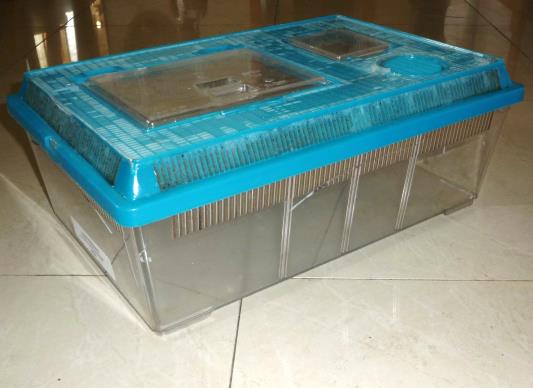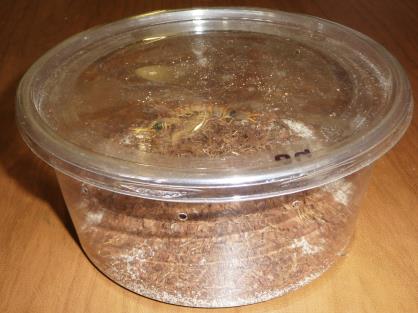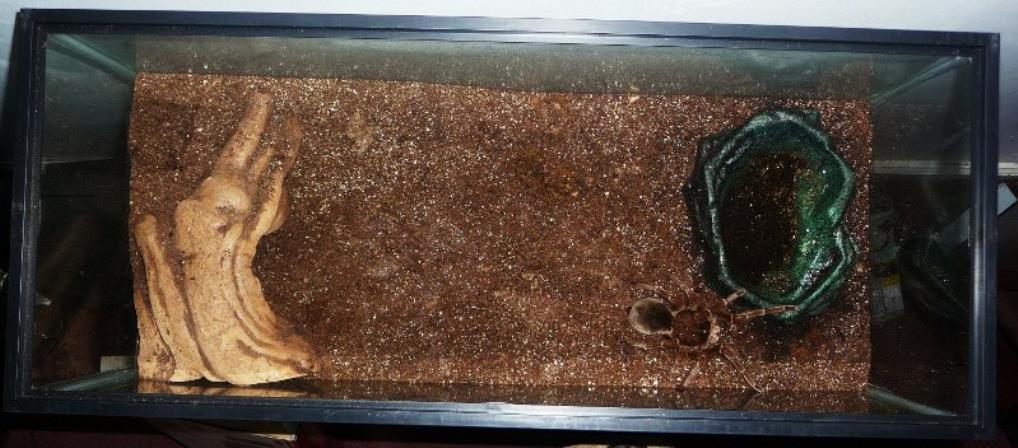Mike's Basic Tarantula
A Basic Site for the Tarantula enthusiast
 | ||||||
 | ||||||
Terrariums


Vials and four inch (10.16cm) deli cup
for a spiderling up to one inch (2.54cm)
Eight inch (20.32cm) deli cup
for juveniles & males
5" H x 3.5" W x 8.5" L
(Dwarf and juvenile tarantula cage)
6.5" H x 5" W x 6"L Terrarium for a
for a three-four inch (7.62-10.16cm) tarantula
6.5" H x 8" W x 14" L Enclosure for a five to seven inch (12.7-17.78cm) teresterial tarantula
8" H x 7.5" W x 11.5" L Used to house a five-six inch (12.7-15.24cm) burrowing tarantulas
6.5" H x 12" W x 18" L - For a seven-nine inch (17.78-22.86cm) teresterial tarantula
12" H x 8.5" W x 15" L - For a seven-nine inch (17.78-22.86cm) burrowing or arboreal tarantulas

This is a twenty (20) gallon aquarium. I use these tanks to house my tatantulas that are eight inches - eleven inches (8" - 11").
Terestrial Setup for a 8" female Brazilian Salmon Pink (Lasiodora parahybana)
Incomplete Terestrial setup for a 9" female Goliath Birdeater (Theraphosa blondi)


All rights reserved, ©
All photos on this website are courtesy of Mike Basic Tarantula unless stated otherwise. It's prohibited to copy without permission of author.
The terrarium is the most important element in successfully keeping tarantulas. A tarantula does not need a lot of food to live and be healthy, but their environment is essential for the health and longevity of the animal. A tarantula doesn’t need a lot of space either. I have been keeping tarantulas since 1988. My first tarantula, I kept for twelve years before I purchased another. I have about fifty tarantulas that are over ten years old. I contribute the longevity to the proper setup of the terrarium. If the terrarium is properly setup to meet that particular species need, their lifespan should be extended beyond the lifespan of a wild species, especially if the tarantula was purchased as a captive born species. This is why I included a geographical habitat with the environment in the care sheet for each species.
When setting up a terrarium, read the care sheet to make sure that the enclosure meets the environmental needs of that particular species.
The main challenge with keeping tarantulas are: there are so many beautiful species available that comes from different parts of the world, which requires a different environmental setup and we want them. The more species you acquire from different regions of the world, the greater the challenge is to meeting these environmental conditions. The less you are able to give your pet the quality care that they need, the more casualties you will have. For an example, I purchased a spiderling Megaphobema mesomelas, which is indigenous to Costa Rica. I already owned and successfully bred the Davus fasciata, which is also from Costa Rica. I kept both of them in the same environment and after about six months the M. mesomelas died. I decided to do my homework on this species and found out that even though both species are from the same country the M. mesomelas is from a high altitude, where the average temperature is around 68° and the D. fasciata is comfortable with temperatures in the low eighties. I live in Miami, FL where the average temperature is in the eighties and my tarantula room is not air conditioned. In order to keep certain species healthy, I needed to keep them in an air conditioned room.
I had one spider the first twelve years that I was in the hobby. Within the next twelve years, I acquired over one hundred species of tarantulas. To some, temperance may not be a problem, but for me, I had to own every new species on the market. After twenty years, the passion to own every new species that was on the market has wane; now I am interested only in a certain Genus or species with a particular environmental need. Make sure you know your limitations and don’t let your eyes override good reasoning. Here are pictures of some terrariums that I use for different species, from spiderlings to adults. From the small vial to the twenty gallon aquarium, the ecological needs of your tarantula can be met.
An arboreal tarantula needs a vertical enclosure with a climb and a lot of ventilation. The substrate of an arboreal is not essential, except to help with humidity. An opportunistic burrower terrarium should be horizontal with restrict climbing. There should be a hide available for shelter. The obligate burrower needs a cage with a burrowing depth of substrate twice the length of its body. You may keep some obligate burrowers as an opportunistic burrower, but to compensate for the lack of substrate most will web up the terrarium. A tarantula that lives in an enclosure that simulate its natural habitat will live longer and exhibit its natural behavior.
The Pros and Cons of using Live Plants in a Tarantula Setup:
I have seen elaborate terrariums with various plants and rock formations, lighting and automatic misting that was very attractive. But it wasn't practical. If you only have a couple of tarantulas and have done your homework on the ecological system of that particular species you have, and have some experience in caring for tarantulas and plants, you may be able to do it, but there are other things you must factor in. While the vivarium setup with live plants looks great, you must consider the maintenance for the tarantula and the plants without compromising either living conditions. A bare terrarium allows the tarantula to be more efficient in hunting for prey. This is the type of setup I use for all of my tarantulas, along with a hide and a water dish. It make maintenance easier, especially if you have as many tarantulas as I have.
The setup with plants may simulates most tarantula's natural environment, but will allow prey to escape. If you choose this setup you will need some in-house cleaners, Pill-Bug, Rolly-Polly (Armadillidium vulgare). I only have one live plant setup, it's in my office.